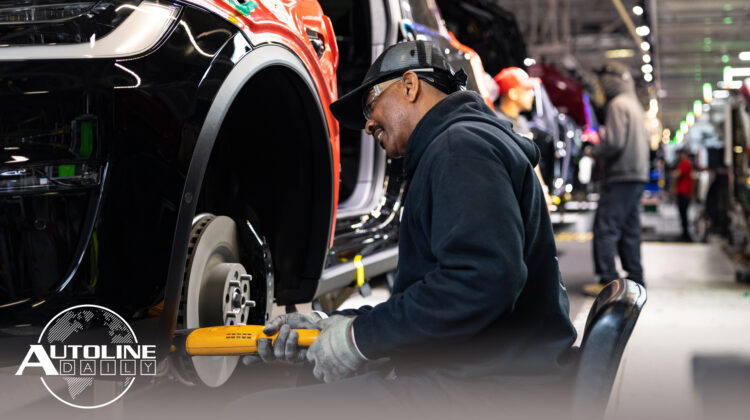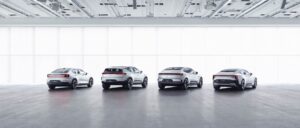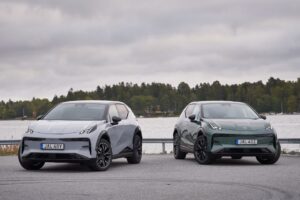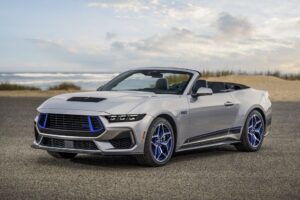
Follow us on social media:
Runtime: 10:22
0:00 UAW Targets Transplants & EV Startups
1:11 Polestar Won’t Break Even on EVs Until 2025
2:25 Volvo Buying Giant Casting Machines
3:13 EU Backing Off Stricter Emissions
4:17 U.S. Wants Bigger Chinese Tariffs
4:57 Zeekr Moving Forward with U.S. IPO
5:33 Falling Battery Prices Pave Way for Affordable EVs
6:37 Chrysler Getting an Electric Crossover
7:34 Mustang California Special is Back!
Visit our sponsors to thank them for their support of Autoline Daily: Bridgestone, BorgWarner, Intrepid Control Systems, Schaeffler and Teijin.
This is Autoline Daily, the show dedicated to enthusiasts of the global automotive industry.
UAW TARGETS TRANSPLANTS & EV STARTUPS
UAW president Shawn Fain says the union is going to target all the non-union automakers in the U.S. and recruit their workers to join the UAW. After nearly 40 years of failing to organize any of the transplants, the union clearly needs a different strategy and Fain told Reuters “we’re going to find creative ways to get to workers.” Foreign automakers and EV startups such as Tesla and Rivian play a significant role in the U.S. auto industry. Collectively, they have 25 large manufacturing facilities that make engines, transmissions, stampings, and moldings for final assembly. And there are more under construction. All told, the transplants and startups employ about 128,000 hourly workers, compared to about 146,000 auto workers who are UAW members. So if the union can figure out how to organize them, it could practically double its membership of autoworkers.
POLESTAR WON’T BREAK EVEN ON EVs UNTIL 2025
It’s really hard to make money selling EVs. Even companies that are doing better than others at selling electrics are struggling. Polestar sold about 42,000 vehicles through the first 9 months of the year, but it says it doesn’t expect to break even on EVs until 2025. The good news for Polestar is it only sells one model right now, so with several more models in the pipeline it has a chance of meeting its targets. The Polestar 3 & 4 are expected to enter production this year and next. And while Polestar says it needs an estimated $1.3 billion until it hits that break-even point in 2025, it’s getting a cash infusion of $450 million from parent companies Volvo and Geely to help build those new models. By our rough calculation, Tesla didn’t start turning a profit until it was making about 80,000 vehicles a quarter. Since Polestar will be selling more expensive vehicles it won’t have to make that many to turn a profit and hopes to sell 155,000 to 165,000 EVs a year by 2025.
VOLVO BUYING GIANT CASTING MACHINES
About a month ago reports came out that Ford and Hyundai are getting gigacasting machines from the same company that supplies them to Tesla. Those reports also said another unnamed premium automaker in Europe was getting some presses and now we know who it is. Volvo is buying two 9,000 ton presses from Idra to use at a new billion dollar factory in Slovakia. The large castings these machines make combine several, sometimes hundreds, of parts together, which helps reduce manufacturing costs. Volvo’s plant in Slovakia is expected to start making its next-gen EVs around 2026 and will eventually have the capacity for 250,000 vehicles a year.
EU BACKS OFF STRICTER EMISSIONS
The European Union is backing off a proposal for stricter vehicle emissions. Lawmakers are keeping rules in place to limit nitrous oxide, particulate matter and carbon monoxide for cars but they voted to weaken NOx limits for trucks and delay the rules for cars for three years. The proposal originally wanted the new regulations to go into effect in 2025. Automakers and several countries opposed the original rules because they said it would be too costly. And they argued that since the EU will ban the sale of new ICE vehicles starting in 2035, that automakers should focus on investing in electric vehicles instead of trying to make ICE vehicles more efficient.
U.S. WANTS BIGGER CHINESE TARIFFS
There’s growing concern over low-cost Chinese EVs flooding foreign markets. Over in Europe, an investigation was launched to potentially slap tariffs on Chinese made EVs sold in the region, which would help protect European automakers. And now in the U.S., a group of bipartisan representatives sent a letter to the Biden Administration urging it to increase the tariff on Chinese made vehicles, which is currently at 25%. They also want to prevent Chinese automakers from exporting vehicles to the U.S. from Mexico. Like Europe, this an effort to protect the U.S. auto industry.
ZEEKR MOVING FORWARD WITH U.S. IPO
And while lawmakers want to restrict the number of Chinese vehicles sold in the country, Reuters reports that Chinese automaker Geely’s premium brand Zeekr, is moving forward with an IPO in the U.S. The company is expected to reveal details about its plans sometime this week and its shares could start being traded within weeks of the announcement. Goldman Sachs and Morgan Stanley are reportedly underwriting the IPO. And it’s not stopping at the U.S. Zeekr also announced plans to expand into Europe as well.
FALLING BATTERY PRICES PAVE WAY FOR AFFORDABLE ELECTRICS
A number of automakers, including Tesla, Volkswagen, Stellantis and Renault, are all developing low cost EVs that are expected to be introduced in the next few years. And a big reason they’ll be able to do that is because battery prices are expected to fall significantly. According to Goldman Sachs, battery prices are expected to drop to $99 per kWh by 2025, which is 40% lower than prices in 2022. And Goldman estimates that battery prices will fall an average of 11% per year from 2023 to 2030. A big reason for the drop is because battery raw material prices have tumbled this year. As we reported earlier in the week, lithium is down 70%, nickel has fallen 40% and cobalt is down too. And they’re expected to remain low because supplies are higher than demand. So that’s why automakers are confident they can develop low-cost EVs now.
CHRYSLER GETTING ELECTRIC CROSSOVER
Chrysler’s sad little lineup of only two vehicles is going to grow to three and that vehicle is going to be electric. Brand CEO Chis Fuell said its next model will be a purely electric crossover in 2025 and it is inspired by the Airflow Concept. That’s a bit surprising because head of design Ralph Gilles said earlier this year, the vehicle wouldn’t have anything to do with what we’ve seen from Airflow so far. So, we’ll be interested to see what this model looks like. But it’s going to have to change at least a little bit because the concept was based on the current Pacifica platform, while the actual production vehicle is based on the STLA Large platform. And speaking of the Pacifica, Fuell also said the hybrid version of the minivan will be sticking around until the end of the decade.
MUSTANG GT CALIFORNIA SPECIAL BACK!
One of the Mustang’s more iconic packages is making a comeback for the new generation pony car. Ford revealed the new GT California Special, which is highlighted by bright blue accents both inside and out. My favorite touch is the repeating California Special script on the black stripe that runs along the lower part of the body. From a distance it just looks like a subtle pattern. The original Mustang GT California Special was made in 1968. It didn’t make a comeback until 2007, but it’s been offered on every generation Mustang since then.
And a quick reminder that Autoline After Hours goes live this afternoon at 3PM EST. John and Gary are going to try and find out if we’re reaching the end of affordable cars.
But that’s a wrap for today. Thanks for joining us.
Thanks to our partner for embedding Autoline Daily on its website: WardsAuto.com










I suspect GM and Ford are not big supporters of higher tariffs on Chinese vehicles, at least not yet, with Buick Envision coming from China, and the next generation Lincoln Nautilus to be imported from China.
One of the greatest safety design changes in the automotive industry was the implementation of crumple zones. Allowing the energy of a collision to be absorbed by the vehicle and not transferred to the occupants. This made vehicles less ridged in places and replaced the old chrome plated steel bumpers to a frame with shock absorbing beam to a unibody construction. I really wonder how these mega-castings will fair in this type of design and the cost and ability for them to be replaced.
I would be in favor of a Chinese auto tariff if that money was then used to fund the EV tax credit and not just go to the treasury dept general fund.
lambo2015 – the giga casting take all the past learning of energy absorption / G-force on the occupants and take it to the next level. Tesla vehicle are getting fantastic crash rating (including offset crash). You will see other OEM adopting this technology to stay competitive (may have already started capital investments). Watch some of the Sandy Munro videos on gigacastings or his interviews with John.
@Lambo: I thought those Giga Castings allow for complex 3-D designs which could make for good crumple structures. Or am I wrong here? I am not an expert so please explain.
MotorTrend did a piece on China made vehicles in Mexico recently. There has been China made Tesla already sold in Canada.
Tier1 supplier Linamar is building a factory in Welland Ontario with 3 – 6,100 tonne gigacasting presses. First from a supplier in North America for an unspecified OEM.
Looks like the big casting idea has caught on.
Norm T how much cheaper was the Chinese Tesla vs. a US built one. ? If there is no difference in price this is why tariffs need to be seriously stiff or North American production will cease so companies can make bank.. I wonder how that would go over with UAW, Because when high priced US built vehicles don’t sell Manufacturers will use that as the excuse to close those plants . They will have won a battle will have lost the war.
Have Teslas both with, and without the “gigacastings” been crash tested, and the results compared? With Tesla making constant changes not aligning with traditional model years, it might be hard to know what has been tested, and how the different ones compare.
Sean, if you aren’t going to number the forum entries can you mimic YouTube and let us comment on each entry right below it so that we don’t have to guess what the comment response refers to? Thanks.
If the tariff of 25% is not enough to keep Chinese cars down to a dull roar in the U. S., I wonder how much it needs to be. 25% is enough of a head start . Protectionism is ok if the country as a whole benefits. But if the benefit is only for a few manufacturers, it raises the cost of living for everyone else and that’s not ideal.
Outside the auto industry, how many people want less expensive cars versus how many are getting their knickers in a knot about the potential of Chinese car imports? I think people want less expensive cars.
Mike & Wim I am not an expert on vehicle structures either. I suppose the castings can be designed with specific break points in place to act like a crumple zone. I just think of castings being very stiff, ridged and not great when it comes to energy absorption. The cost savings I’m sure is there as it reduces the complexity and processing so adoption by other automakers doesn’t surprise me from a manufacturing standpoint. Tesla has great crash results due to the over-all design and does the mega-casting help or hurt the crash worthiness?
I have seen articles that claim insurance companies are reluctant or flat out will not insure an EV that has been involved in an accident. I’m guessing that has more to do with battery safety but could also be them learning the costs involved in repairing a vehicle with a mega-casting.
So far, the cars coming from China to the US are semi-premium ones from Buick and Volvo, and soon, Lincoln. Is that because the Chinese home market is the biggest market for these vehicles?
Albemarle; Everyone wants less expensive everything. So, where does it stop? Without the tariffs the auto industry will go the way of our TV and electronic manufacturers, Our steel industry, our microchip industry, our clothing industry. Even iconic American brands aren’t even made here anymore like Apple phones, Nike & Converse, shoes, Wrangler & Levi Jeans, Ray Ban sunglasses, Barbie dolls, and Huffy & Schwinn bikes, Radio Flyer wagons. Even ironically the American girl dolls which are expensive enough to be manufactured here are made in China.
We can give up protectionism so the consumer can buy cheaper products, but the end result is nothing being manufactured here. With no good paying manufacturing jobs people will need cheaper products because all that’s left is service jobs. We just continue spiraling downward until China owns us financially and we depend on them too much like we realized with the chip shortage. Trying to compete with China is a lose lose for America.
Lambo, manufacturing for the Great American War Machine will probably stay in the US, though Russian engines are used for Delta V rockets.
@Lambo: I had not thought about aluminum being more brittle, good point.
Lambo, good reply. China has thumbed its nose at the WTO for decades. It violated patents and developed mandatory business schemes that resulted in the theft of intellectual property. So, what do you do when the trade is not fair? Unfortunately, the greedy #&**$&s in the UAW just nailed their own coffins.
I, too, was under the impression that, while giga castings were good for the build process, they made them too expensive to repair. So that, even a minor collision becomes a total loss for the insurer, on the repair side! So, while the battery pack, if not damaged, may be reusable in a different application, the vehicle’s unibody are not! That said, when Ford went with the aluminum bodies Jaguar XJ and later the F-150, there were concerns that those applications would get a similar treatment as these EVs with giga castings. As I understand, Ford had devised a way around that by making specific sections removable to keep costs down, in the event of a collision. Maybe Tesla and others have found a similar approach, or passive safety solutions to to prevent the collision in the first place?
I’ve asked before, but never got an answer, or missed it. What percent of vehicles are “totaled” because of minor crashes, or crashes in general? Will the use of big castings change that significantly? Surely there is data on this, but I can’t find it.
Drew, by your definition, the UAW is no greedier them the leaders of the company, who sent the assembly jobs to China in the first place! That was THEIR DECISION, not the UAW11 To get more money to line their pockets. Why are the workers the only focus of greed, when the leaders of the OEMs bring home millions? Yes, I will admit that the UAW has made things more challenging for their members, but the corporate greed has gone unabated and has gone on much longer then the employees wanting a piece of the action! It is when the employees want a share, onlookers stand up in protest.
Kit, it may excess, but that is not how the insurance companies work. They insure based on POTENTIAL risk and, in many cases, not on actual claims! If the potential risk is to great, they will not do it. That’s why Tesla, when they first started selling their vehicles, had to insure them themselves, because many insurance companies would cover them.
wmb – Ford learned from their Jaguar experience that aluminum panels can be repaired, but extra training was required to help dealer body shops to learn the techniques.
But giga/mega castings pose the question – are they repairable? They are such a massive part of the vehicle structure, that their replacement is not likely affordable feasible. So, if they can’t be repaired, I’m betting the vehicle will be a total loss.
Aluminum sheet metal on Ford trucks, Jaguars, and Audi A8s would be totally different from huge castings. I’d think a broken casting would be a much bigger issue. I still haven’t heard anything about how often this even comes up. Maybe only 1% of cars or fewer are “totalled” because of minor crash damage.
On these mega-castings all you have to do is look at what it would take to replace one. Maybe welding the casting together will be an acceptable repair. (which would have variable results depending on skill) But if a minor collision to a corner, snaps off part of the casting that also gets left at the crash site I would think they have no choice but to replace the entire casting. The repair just went from replacing a damaged A-arm assembly and fender with 4 hours of labor to replace the damaged parts, to the entire front casting removing the suspension, the steering connections both brakes and drive axles if FWD all the wiring that’s attached and I’m guessing the labor is now closer to 24-30 hours. Price difference of A-arm vs whole front casting??? and price difference of 4 hours labor and 24 hours at $150 an hour. labor alone is $3000 difference.
NOTE: (I’m guessing on these labor times they could be way off, I watch too many shows where they complete a car restoration in 60 min.) But you get the point.
Manufacturers have done this in the past with part complexity reduction. They can save money by making multiple parts into one. Great for reducing assembly cost and part quantity. But then when something breaks, and you just need this little part like say the plastic brake reservoir tank which should be $15 at the most. But they dont sell just the tank you need to buy the entire master cylinder at $140. So sometimes part consolidation isnt that great for the consumer. Just great for the manufacturer.